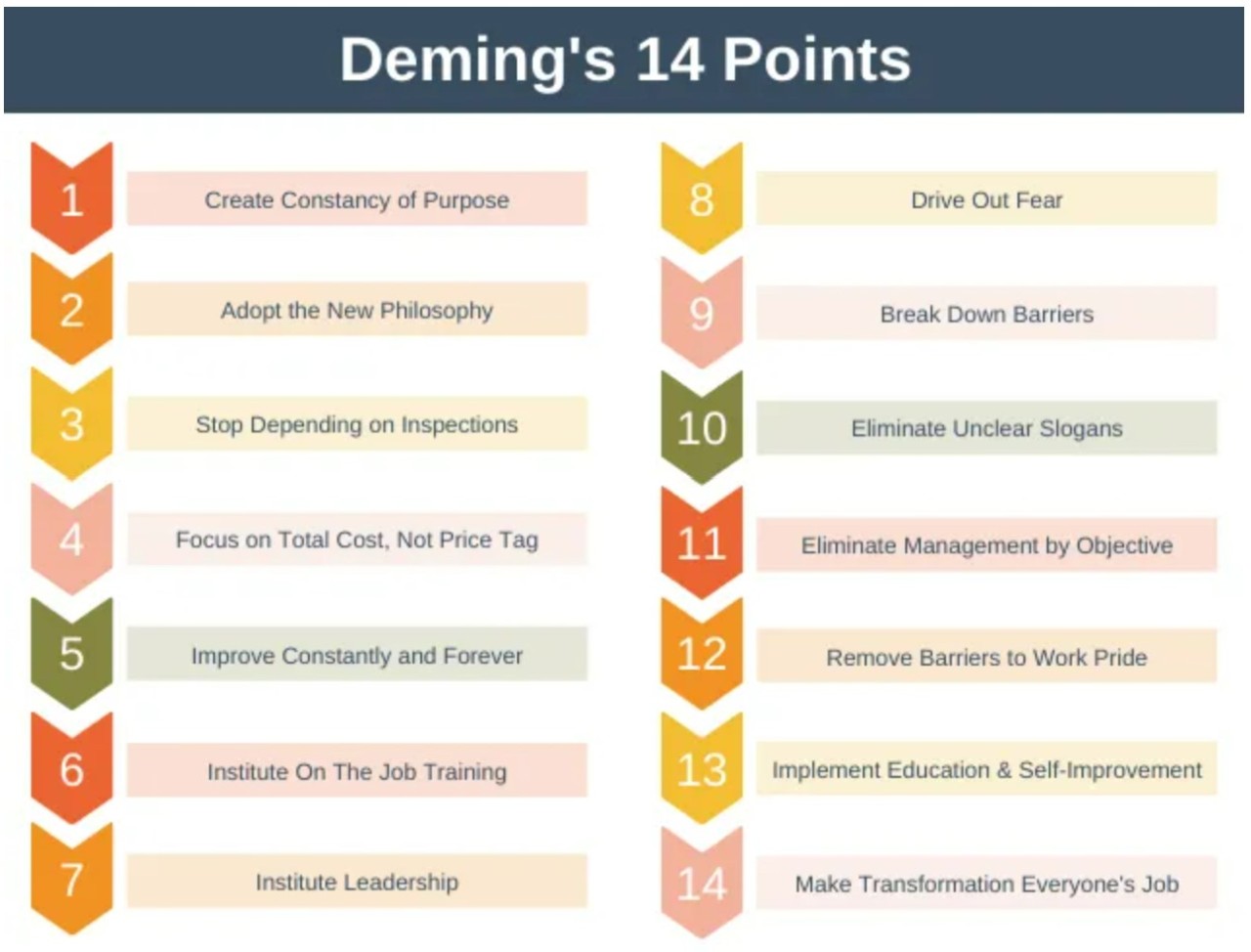Insight Blog
Agility’s perspectives on transforming the employee's experience throughout remote transformation using connected enterprise tools.
8 minutes reading time
(1617 words)
Deming Chain Reaction – UPDATED 2022 – A Complete Guide
The chain reaction lets you reward workers as the company prospers, instead of seeking to prosper on the backs of workers.
Leading a company to enhance quality and focus on continual improvements in service and product quality by reducing the level of variability in service, production, and design is the Deming Chain Reaction. As fewer and fewer mistakes are made in the production of services and goods, quality improvement lowers costs.
As a result of better utilization of machine time and material, this would speed up production and increase output volume. As a result, productivity rises, and the competitive pricing of the products and services expands market share.
Deming Chain Reaction
When Dr. Deming referred to a crisis in the title of his books, the most common response was to cut costs to increase profits. Executive pay and stock prices would rise if a large number of employees were laid off. Sadly, a lot of executives still focus on decreasing costs and laying off employees.
However, the idea that the focus should be on continuous improvement rather than cost minimization is becoming more widely accepted.
You may eliminate waste, reduce errors, and eliminate delays by focusing on continuous improvement. The positive chain reaction that occurs when a corporation reduces expenses while simultaneously increasing production and product effectiveness can be attributed to process improvement. Dr. Deming elaborated on the subject.
The chain reaction allows you to compensate workers as the company grows, rather than trying to grow on the backs of workers. It's not a good idea to reverse the methods and the ends.
Effective management means reducing costs as a result of process improvement.
Cost-cutting measures based on a spreadsheet passed down by executives are doomed to failure if they have even a slight impact on the quality of service given to customers.
If you want to leverage the power of process improvement to boost business efficiency and cut waste, consider working with a consulting team. Specifically, they will help your company build and implement effective solutions to streamline your operations while reducing costs.
Toyota Deming 14 Points
Toyota, Fuji, and Sony, among others, found considerable success after implementing Deming's principles. When compared with global competition, they had a lower cost and a higher quality product.
There was an enormous increase in the popularity of Japanese goods, and by the 1970s, many of these companies were dominating the global industry.
Companies in the United States and Europe understood they couldn't ignore the quality revolution any longer.
Constantly pursue improvement in your life
Make long-term investments in high quality.
Stay away from short-term fixes.
Don't just improve on what you're already doing; come up with new and better ideas.
Predict and prepare for future difficulties, and always aim to improve yourself.
Accept the new philosophical viewpoint
Incorporate quality into all aspects of the business.
Instead of focusing on your competition's demands, focus on your consumers and build your products and services to fulfill their needs.
A fundamental shift in the way business is conducted is on the horizon. It's about becoming a leader, not just a manager.
Develop and put into action a quality vision.
Stop relying on inspections as a checkpoint
To put it simply: inspecting is a waste of time and money because it doesn't actually make things better because it only identifies flaws.
From the beginning to the end, ensure that the procedure is high-quality.
Take a look at your mistakes, but don't only focus on what went wrong.
Prove the process' efficacy not just via physical inspections, but also through statistical control measures.
Get all your products from the same supplier
To achieve high quality, it is necessary to maintain a high level of consistency in both the input and the output. This can be done by working with the same supplier
Suppliers should be viewed as allies in the pursuit of high-quality products. Rather than competing solely on price, insist that they invest time and effort in increasing their own quality. Having the same supplier will make correspondence with them better and faster—hence, so will the monitoring of their product quality. In a nutshell, it will help streamline your logistical operations.
Remember, getting all your products from the same supplier allows you to build a better business relationship with them. Working with several suppliers may only create creases in your operations.
Never stop improving yourself
Improve your systems and processes on a regular basis. The Plan-Do-Check-Act method of process analysis and improvement was popularized by Deming.
Put an emphasis on education and training so that everyone can do their duties more effectively. Also, be more proactive by expanding your knowledge about valuable business trends. Staying informed can lead you to innovative insights and a clear-cut strategic vision for the organization.
Use on-the-job training
Consistency training can assist eliminate inconsistency in performance.
Create a shared understanding of the basics.
Employees should be able to see how they fit in with the overall strategy.
Put leadership into action
Workers and processes should be understood by supervisors and managers.
Don't just watch over your employees; make sure they have the tools and resources they need to accomplish their best work. Don't be a cop, be a coach! Also, practice good leadership by making teamwork a priority. Resolve any teamwork issues so the subsequent challenges will be much easier to approach. Create a people strategy when developing new processes: ask your employees about their opinions or feelings about the changes.
Eliminate any apprehension you may have
Allow people to function at their peak by ensuring that they are not scared to communicate their thoughts or concerns.
Be clear to everyone that the goal is to achieve high quality by doing more things well, and that you're not interested in criticizing anyone when mistakes occur.
Dismantle obstacles in the workplace
Understand that each department or function is a service to other departments that use the result it produces. More importantly, focus on creating a common goal.
Stop using slogans that aren't clear
Don't leave folks guessing about what you desire. Despite its simplicity, "Excellence in customer service" is a vague term that is difficult to define. In what manner is it accomplished? A slogan like "Always strive to be better" conveys the message more effectively.
Eliminate the use of goals-based management
Look at the way things are done, not simply the numbers. Production targets, according to Deming, can lead to an increase in output, but also a decrease in quality.
It is important to provide the necessary resources so that both production levels and quality can be met.
Remove obstacles to pride in your work
Take delight in everyone's work without judging them or comparing them to others.
Make sure your employees are treated fairly and don't have to compete with each other for money or other incentives. As the quality system improves, everyone's work will rise to the same standard.
Educate and improve yourself
Workers' current abilities should be honed.
Educate people on the importance of acquiring new skills in light of the uncertainty of the future they face.
Everyone's job should be to transform things
Have each employee take a step toward quality to improve your total organization.
Think about how each minor step relates to the larger picture.
Companies That Use Deming's 14 Points
A corporation that has consistently followed Dr. Deming's management theories can be found in Toyota Motor. Over the course of its 60-year history, Toyota has adhered strictly to the 14 principles outlined by Henry Ford. Since the original interpretation of these criteria, Toyota has done an excellent job of expanding on the foundation and progressing along with current technology.
Other examples of companies that are using Deming's 14 points include Peaker Services, Hillerich & Bradsby Company, Omnilingua, and Rare Group.
As a result of the book titled Out of the Crisis by Dr. W. Edwards Deming published in 1982, the now-familiar improvement cycle of Plan, Do, Study, and Act was introduced. Deming outlined a management theory he dubbed the "14 points" in his book. Deming's 14 principles, a collection of philosophical and programmatic ideas, gradually solidified into what is currently known as Total Quality Management (TQM).
The initial 14 principles spawned a slew of innovative manufacturing and cost-cutting tools and approaches. New methods of thinking about management have emerged in response to the evolving productivity landscape. These new ways of thinking stress continuous improvement, process reform, and the analysis of Smart Factory data.
Deming's 14 points of excellence were established and became renowned during this period, and he also introduced a new approach to corporate management. Because of his expertise, new methods like Total Quality Management, continuous improvement, and lean manufacturing have been developed. Companies all throughout the world have raised their performance and quality standards by implementing Deming's approaches. Worximity's Smart Factory analytics have been influenced by the 14 manufacturing touchpoints, making our facilities more productive and dependable.
Deming Chain Reaction Example
OPCO Construction Ltd., Wales, UK is a good example.
In order to achieve maximum efficiency in its operations, OPCO Construction Ltd. has used Deming's 14 principles since its inception in 2001. The modest, privately owned corporation realized that all businesses believed in projects that were on time, on budget, and of acceptable quality. OPCO, on the other hand, was not satisfied with only meeting industry standards. OPCO's 14 visions, a company-wide initiative, were put in place by the business.
Each of Deming's 14 points was built upon the 14 visions in a way that was relevant to OPCO's particular company and objectives. People, communications, procedures, and technology were the four main areas of concentration for the long-term initiative.
Categories
Blog
(2622)
Business Management
(323)
Employee Engagement
(212)
Digital Transformation
(176)
Growth
(119)
Intranets
(116)
Remote Work
(61)
Sales
(48)
Collaboration
(36)
Project management
(29)
Culture
(28)
Customer Experience
(26)
Knowledge Management
(21)
Leadership
(20)
Comparisons
(6)
News
(1)
Ready to learn more? 👍
One platform to optimize, manage and track all of your teams. Your new digital workplace is a click away. 🚀
Free for 14 days, no credit card required.













![What Is an Intranet for Business? [2026 Guide] What Is an Intranet for Business? [2026 Guide]](http://agilityportal.io/images/easyblog_articles/1496/b2ap3_thumbnail_What-Is-an-Intranet-for-Business.png)


